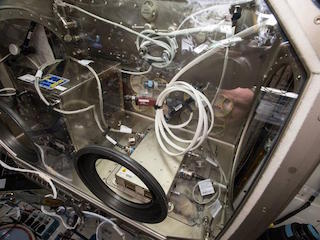3D Printers in Space: How the Maker Movement Made It to the Final Frontier
Crew members of the International Space Station recently installed a 3D printer on the station. Here's a look at how the technology came to space.
Crew members aboard the International Space Station (ISS) recently put a very interesting thing into orbit—a 3D printer. The printer, created in tandem by Lowe's and a company called Made in Space, could be used to produce tools and items needed in case of an emergency, or just for everyday use. The printer was installed during the week of June 27, 2016 by NASA astronaut Jeff Williams. While there are multiple types of 3D printers, the model in question prints models using plastic filament in a process called fused deposition modeling (FDM). So far, it has produced a Kobalt-branded wrench to be used for projects on the ISS.
 3D Printer in Space. Image credit -NASAThe printer initially made its debut in 2014, when it was used on the ISS to print a ratchet from plans that had been sent up from earth. One of the key use cases for on-demand manufacturing will be for longer flights, even ones that could take astronauts out past the moon. "For the printer's final test in this phase of operations, NASA wanted to validate the process for printing on demand, which will be critical on longer journeys to Mars," said Niki Werkheiser, the space station 3D printer program manager at NASA's Marshall Space Flight Center in Huntsville, Alabama.
3D Printer in Space. Image credit -NASAThe printer initially made its debut in 2014, when it was used on the ISS to print a ratchet from plans that had been sent up from earth. One of the key use cases for on-demand manufacturing will be for longer flights, even ones that could take astronauts out past the moon. "For the printer's final test in this phase of operations, NASA wanted to validate the process for printing on demand, which will be critical on longer journeys to Mars," said Niki Werkheiser, the space station 3D printer program manager at NASA's Marshall Space Flight Center in Huntsville, Alabama.
Typically, it can take months, or even years, to get something up to the ISS, depending on how the resupply missions are scheduled. However, additive manufacturing technology could get tools and parts in the hands of astronauts in a matter of hours. This could be especially helpful in an emergency situation. When developing the printer for space travel, the first consideration was how it would be affected by gravity. However, the team found that, without the pull generated by gravity, they were able to produce certain prints more easily in space...
- Login to post comments